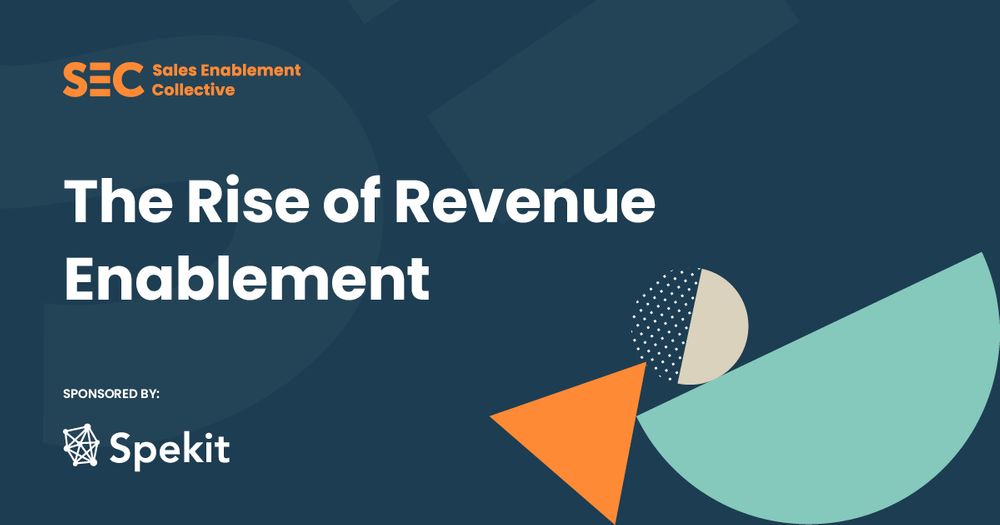The phrase ‘revenue enablement’ is one we’re hearing more and more about, have you noticed? It’s a theme we’ve been exploring in detail here at SEC, with the launch of the Rise of Revenue Enablement report, in which we interviewed revenue and enablement experts on the topic.
The consensus seems to be that the C-suite is waking up to the business value of sales enablement, and that rolling it out across all customer-facing teams - everyone who’s involved in generating revenue - just… makes sense.
Here, we pick the brains of Spekit CEO & Co-Founder, Melanie Fellay. We'll be discussing:
- Differences between revenue enablement and sales enablement roles
- What's driving evolution of sales enablement
- The impact on the customer experience
- The impact on employee experience
- How to demonstrate the value of enablement
Q. How is the revenue enablement role different to sales enablement?
A. Revenue enablement to me is really an evolution of sales enablement. As organizations start to realize how much of their revenue comes from expansions in B2B SaaS, they’re beginning to take a more holistic, end-to-end approach with their enablement.
If you look at your sales process with a wider lens, you realize that, yes, it starts when you first engage with a customer and the interactions that occur throughout getting them to close. But, so much of that process of getting buy-in, identifying champions and driving expansion happens post-sales.
So, where sales enablement looks at enabling your team to close deals faster, revenue enablement takes the lens of looking at every single interaction the buyer has within the customer journey. They’re focused on ensuring there’s alignment throughout each touchpoint: from the way we sell the product, to how we talk about it, to how we train on it and beyond.
Q. Do you see revenue enablement as an evolution of sales enablement across the industry? What’s driving this?
A. One hundred percent. The whole idea is thinking about revenue as it relates to every interaction with the customer, vs. just pre-sales. SaaS companies live and die by their subscription metrics. Acquiring a net new customer can cost five times more than retaining an existing one.
Through the same lens, it’s significantly less expensive to land and expand with existing happy customers than it is to acquire net new. There will always be a place for both.
But, with the right level of enablement in the post-sales process, for example, a focus on how your customer success org educates, trains and enables customers - there’s easier revenue to be earned on the customer side.
Q. How will this impact the customer experience?
A. I think it will create a much smoother overall customer experience. If you think about revenue enablement as mirroring the end-to-end customer journey and ensuring each team is responsible for interacting and enabling the customer throughout every point, you’ll naturally create a smoother, more consistent brand experience and reduce any friction or confusion in the process.
When everyone is speaking the same language, touting the same value propositions, customers develop a deeper connection with your brand, which ultimately leads to higher outcomes and results.
Fancy a customizable customer journey template like the one below👇 (plus dozens of others, 300+ hours of expert talks from our revenue & enablement events, and regular exclusive insights straight to your inbox)? Head over to our membership plans.
Q. How will this impact the employee experience?
A. Companies are starting to realize more consistency across the board. When it comes to SDR vs Sales vs Success from an enablement standpoint, there are going to be things that are really unique to each role that you’ll have to enable them on. But, there’s also a lot of things in common across these three roles, such as:
- Who is your customer?
- What do they care about?
- How do you drive success?
- How do you speak to them?
If you’re able to take more of an end-to-end lens, you’ll have a much more consistent approach to your enablement that will hopefully reduce the friction and inconsistencies between approach and messaging. Suddenly, the same person who’s thinking about how to make the AE successful is also thinking about how to make CS successful.
When you have the same team focused on enablement throughout every touchpoint, you’ll see more consistency in process, approach, hand-offs and ultimately, delivery.
Q. How can you demonstrate enablement’s impact on revenue and the value that it adds?
A. Instead of looking at enablement as strictly a revenue driver, you need to demonstrate how enablement impacts your various business objectives. Identify your larger goals as an organization and how enablement will play a part in reaching those goals. For example, if you’re aggressively hiring and have set a goal of reducing the time it takes to ramp new reps, you can measure how different enablement initiatives impact overall ramp time.
Aside from quantitative metrics, there are qualitative factors to consider. I always recommend implementing a post-sales process survey. How do your reps gauge their proficiency levels after closing a deal? After onboarding? Implement measures to gauge feedback throughout the touchpoints within the buyer’s journey to identify what’s working and areas for improvement.
Download the Rise of Revenue Enablement, featuring experts tips and tricks for turning your organization into consistent revenue-generating powerhouse👇



